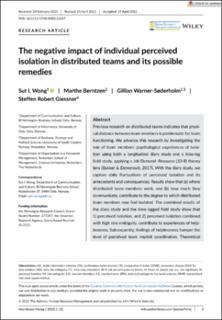| dc.contributor.author | Wong, Sut I | |
| dc.contributor.author | Berntzen, Marthe | |
| dc.contributor.author | Warner-Søderholm, Gillian | |
| dc.contributor.author | Giessner, Steffen Robert | |
| dc.date.accessioned | 2022-07-21T09:19:03Z | |
| dc.date.available | 2022-07-21T09:19:03Z | |
| dc.date.created | 2022-05-30T07:35:54Z | |
| dc.date.issued | 2022 | |
| dc.identifier.citation | Wong, S. I., Berntzen, M., Warner-Søderholm, G. & Giessner, S. R. The negative impact of individual perceived isolation in distributed teams and its possible remedies. Human Resource Management Journal, n/a(n/a). | en_US |
| dc.identifier.issn | 0954-5395 | |
| dc.identifier.uri | https://hdl.handle.net/11250/3007477 | |
| dc.description.abstract | Previous research on distributed teams indicates that physical distance between team members is problematic for team functioning. We advance this research by investigating the role of team members' psychological experiences of isolation using both a longitudinal diary study and a time-lag field study, applying a Job Demand–Resource (JD-R) theory lens (Bakker & Demerouti, 2017). With the diary study, we capture daily fluctuations of perceived isolation and its antecedents and consequences. Results show that (a) where distributed team members work, and (b) how much they communicate, contribute to the degree to which distributed team members may feel isolated. The combined results of the diary study and the time-lagged field study show that 1) perceived isolation, and 2) perceived isolation combined with high role ambiguity, contribute to experiences of helplessness. Subsequently, feelings of helplessness hamper the level of perceived team implicit coordination. Theoretical and practical implications for managing distributed teams are discussed. | en_US |
| dc.language.iso | eng | en_US |
| dc.publisher | John Wiley & Sons Ltd. | en_US |
| dc.rights | Attribution-NonCommercial-NoDerivatives 4.0 Internasjonal | * |
| dc.rights.uri | http://creativecommons.org/licenses/by-nc-nd/4.0/deed.no | * |
| dc.title | The negative impact of individual perceived isolation in distributed teams and its possible remedies | en_US |
| dc.type | Peer reviewed | en_US |
| dc.type | Journal article | en_US |
| dc.description.version | publishedVersion | en_US |
| dc.rights.holder | © 2022 The Authors. | en_US |
| dc.source.pagenumber | 22 | en_US |
| dc.source.volume | n/a | en_US |
| dc.source.journal | Human Resource Management Journal | en_US |
| dc.source.issue | n/a | en_US |
| dc.identifier.doi | https://doi.org/10.1111/1748-8583.12447 | |
| dc.identifier.cristin | 2027981 | |
| dc.relation.project | Norges forskningsråd: 275347 | en_US |
| cristin.ispublished | true | |
| cristin.fulltext | original | |
| cristin.qualitycode | 2 | |

